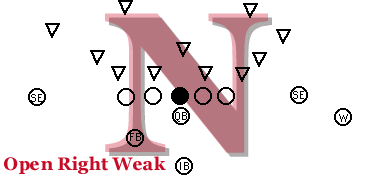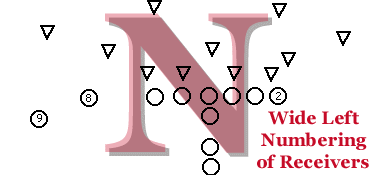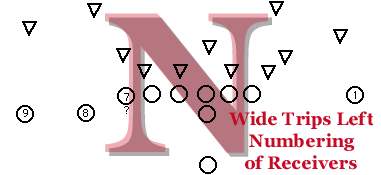

Nebraska, like all football teams, has a specific system for calling plays in the huddle and at the line of scrimmage. This is an outline of the Husker play-calling system that I've picked up from talking to high school coaches and listening to Nebraska coaches talk in public forums. The HuskerVision video Crystal Clear and the PBS documentary A Day in the Life of Nebraska Football were both helpful because coaches' headset conversations are included.
FormationWhen the play is called, the first words signify the formation. The formations are called to the right or the left (unless it is a balanced formation like Ace or Power).
Examples: Pro Right (see right) Tight Left Ace |
|
Fullback alignmentThe formation call will sometimes indicate that the fullback is offset to either the strong or weak side. For example: Pro Right Weak would but the fullback behind the left (weakside) tackle. Pro Right Strong would but him behind the right tackle. NU has shown a tendancy to use this to buy the FB a couple steps in running Arc Option his way or to run inside zone the other way with the fullback closer to his backside cutback assignment. In the Tennessee Fiesta Bowl they ran Counter Trap lead toward the off-set FB and had him lead te play.
Examples (notice there must be FB formations): Pro Right Strong (see right above) Tight Left Weak Open Left Weak (see right below)
|

|
After the formation is the play call. Nebraska calls running plays by signifying the ball carrier and the hole the play is to attack. This is signified by a two-digit number. Each back is assigned a number:
Numbering the BacksThe first digit of the play number usually tells which back will carry the ball. (There are exceptions.) |
|
|
|
Numbering the holesThe second digit tells the hole on the line of scrimmage to be attacked. The holes are numbered from right to left from one to nine. Hole number 1 is outside to the right; hole number 9 is outside left; the numbers in between each signify a lineman. |
Examples:
Pro Right 15 (QB sneak behind center)
Open Right 41 (I-back carrying ball around right end)
Tight Left 34 (fullback carrying ball behind right guard)
Special Right 27 (wingback carry ball off left tackle)
Because several different types of plays can involve the same ball carrier heading to the same place, the next word in the play call signals the type of play. This is an area of Husker play calling that is murky to me. I've picked up some of the words that the Huskers use; others I'm guessing at. The following examples I'm fairly sure of.
Examples:
Pro Right 15 smash (the above QB sneak)
Open Right 41 outside (this is a hand off, often called a stretch play by TV people)
Open Right 41 pitch (Nebraska's famous sweep)
Tight Right 34 trap (tells line to trap block for the FB)
Tight Right 34 curl (tells line to use zone blocking)
Special Right 27 shovel Pass (WB will get ball by shovel pass)
Option numbering is somewhat confusing to me. I think some of the numbers assigned options and option companion plays may have developed over the years from other complementary plays that are no longer a part of the Husker offense.
Nebraska option play call examples:
11 wall (inside trap option to the right; makes sense because QB carries around end often)
32 option (belly option to right even though fullback is not going to carry ball)
31 sprint option(speed option to right is numbered with 3 even though QB can keep and there is no FB)
41 sprint option (arc option to right is numbered
11 veer option (dive option to right; confusing part is that FB dive give is called 11 veer, not 33)
Some other plays seem to not match the numbering system. I think this is usually because of companion plays. For examble the QB off-tackle isolation play is called 34 QB keep, not 13, even though the QB carries off-tackle. This is a companion of the 34 trap which is faked before the QB follows the I-back off tackle.
When the quarterback carries a counter sweep, the play is called 42/48 Quarterback Coutnersweep instead of 12/18 Countersweep.
Another is mentioned above: 11 veer. This is a handoff to the fullback between guard and tackle and would be a 32 or 33 by the numbering system. The QB and I-back option associated with this play is 11 though, so the dive takes the same number.
The pass calling system is even more of an enigma. Play-action passes are called using the run number and the word pass.
Example:
Double Wing 19 wall pass (play fake is wall option to the left)
Non play-action passes are designted with a number to signify the type of drop the QB will take.
51= sprint out right
59= sprint out left
53= sprint draw play-action right
57= sprint draw play-action left
52= pitch play-action to right
58= pitch play-action to left
71= five-step drop behind center
79= five-step drop with QB opening to his throwing hand
91= three-step drop behind center
99= three-step drop with QB opening to his throwing hand
Example of pass call from A Day in the Life of Nebraska Football:
Shotgun 79 Audible
I have no idea of the significance of the word, but I imagine it may set the pattern. Or it may be that hte pattern would be called at the line.
Receiver Numbering:Examples I'm fairly sure off: 1 far right wide receiver 2 second receiver in from right or TE on right if no wide out 8 second receiver in from left or TE on left if no wide out 9 far left wide receiver
Examples I'm less sure of: 3 third receiver in from right in a trips formation 7 third receiver in from left in a trips formation |


|
This is true even of the wingback. He is not called 2 for passing purposes. I'm also unsure if a TE can ever receive a 1 or 9 number even if there is no wide receiver on his side. I think the TEs are probably always numbered 2 or 8. I don't think a receiver's number changes just because they go in motion; I think they are numbered by their initial position. Did I mention this was an enigma?
Examples:
Pro Left 38 option pass 9 corner 8 flat
Spread Right 47 dive pass 2 delay flat
Next in the play call is a motion call. Nebraska has changed their motion call system in the last two years under Coach Solich. The length of the play calls below, heard from Osborne in A Day in the Life of Nebraska Football, shows why the change was made
|
Examples: Pro Left 38 option pass 9 corner 8 flat short motion Spread Right 47 dive pass 2 delay flat flanker motion |
|
I know of a couple standard motion systems, but don't know what Solich and crew have developed.
Finally, a play call may be called with the word 'check' at the end. I believe this to mean that the QB has the option of changing the play at the line to the same play in the opposite direction.
In A Day in the Life the following call is followed by its opposite play:
Tight Left 36 trap check (on highlight FB carries over right guard, the 4 hole, instead of left guard, 6)
In Crystal Clear a similar situation happens:
Double wing 19 wall check (on highlight wall option is run to right instead of left)
Nebraska obviously uses a lot of different personnel groups in these different formations. This requires a lot of coordination on the sidelines. Since it is primarily receivers who are shuffling in and out of the huddle, Receiver's Coach Ron Brown works with Coach Solich to get the right people on the field. Here's the process:
1. - When the previous play ends the linemen huddle up, but the backs and receivers wait to see if they will be included in the next play. They can't enter the huddle because NCAA rules prohibit any one who enters the huddle from then leaving the field before a play is run.
2. - After Solich and his head-setted comrades decide on the play, he tells Coach Brown the formation and gives the play to a receiver to shuttle into the quarterback
3. - Coach Brown uses arm signals to communicate the next formation to the players waiting on the field. This helps them know whether to enter the huddle or leave the field. I would assume they also take a look at the personnel with whom Solich is sending in the play.
4. - The correct personnel then huddle up and the play is called
The complicated number of formations and player groups sometimes causes NU to burn a time out. This is very frustrating to some fans, but I believe it is a good trade-off for the sophistication of the Nebraska offensive system.